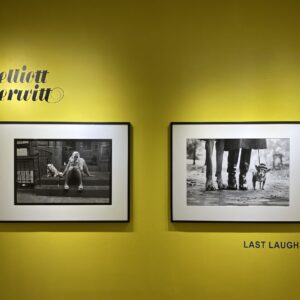JTF (just the facts): Published in 2022 by The Everyday Press (here). Softcover, 210 x 145 mm., 160 pages, with 124 black and white photographs. Includes an introduction by the artist, and an interview moderated by Jon Wood. Design by Joe Hales studio. In an edition of 500 copies. (Cover and spread shots below.)
Comments/Context: After collecting and considering photobooks for a few decades, I sometimes think I’ve seen everything. But of course that’s not true, as photographers are only too happy to prove. They’re an industrious bunch, publishing outliers with surprising regularity. Books like Luke Stephenson’s British Record Fish (reviewed here) and Nick Relph’s Eclipse Body Soul Syntax Soul Syntax (reviewed here) can be broadly categorized as picture books, but the photographs are not proffered as aesthetic achievements. Instead the images are tools deployed toward an ineffable ulterior motive.
Those examples came to mind when considering Sean Dower’s Monumental Guns And Their Targets: A Field Guide For London, a recent monograph which carves its own path. Take the vanilla production for starters, designed with all the glamour of a military briefing. It’s a small perfect bound paperback with covers of unbleached card stock. There is no photo, image, or ornamentation on the plain brown cover, just the book title in serif all-caps. The interior contents are orderly, a small army of photographs marching in step, printed in flat greyscale, all equally sized. They deliver exactly what the title promises. On one side of each spread is Dower’s photograph of a “monumental gun” (a double entendre referring to both size and historic value). On the opposite page is a picture of the theoretical zone of impact, if the defunct gun could somehow fire ammunition.
Note that the word “gun” is used by Dower as a catch-all to cover a variety of heavy weapons. Most are cannons and large artillery, made of bronze or iron and mounted atop wheeled scaffolds. There are also two modern battle tanks for good measure, both sporting monumental gun barrels. All served as an actual weapon of war. London has been the unfortunate host of countless battles, and leftover munitions are strewn throughout. Many have been decommissioned and converted into war memorials. Some were moved to parks or interpretive sites, many left in place. For this project, Dower limited himself to the ones which were publicly accessible. Two schematic maps mark the sites of monumental guns and their strike points with asterisks. Although informative, the maps seem more decorative than useful. But those curious to track down the sites needn’t worry. A rear index lists the exact geographic coordinates.
Judging by this book, London’s guns are scattered like buckshot. Some sit atop special platforms or brick walls. Many are aimed at or across the Thames, defending against former marine threats. Occasionally a lonely gun is left to fend for itself in a parking lot or grassy berm. Dower approaches all with perfunctory style, typically shooting from behind or to the side at several paces, centering his subjects in the frame. The target zones are more speculative. They include everything from buildings to trees to brick walls to an open field with distant livestock. One target is a mass of blank water, presumably the river. Another shows an empty patch of sky.
During wartime, a projectile might have landed at any time or place without warning, and Dower’s photographs are shot in much the same spirit. But the subject matter has been safely defanged, and their historic remove affords him an ironic vantage. Functional guns are relatively rare in contemporary British society. They’re not even carried by policemen typically, a sharp contrast to the urban landscape spiced with inert weapons. In America the situation is almost exactly reversed. Monumental guns are limited to a few historic sites east of the Mississippi, while the country’s citizenry is armed to the teeth. Dower’s project is endemic to London.
Locating the city’s many monumental guns required months of legwork, and identifying their targets was an even greater challenge. After researching the make, model, size, and provenance of each gun to get a sense of its range and accuracy, Dower then calculated the direction of fire, angle of elevation, air drag, ammunition size, and sightline to the nearest obstacle. It was only then that he could locate and photograph the strike zone. Exact specs for each gun are included in the exhaustive index. Along with the schematic map, they give the book a spirit of earnest dedication. It’s all deadly serious, or at least it was during wartime. But viewed now in book form the material comes across with a wink and a nudge.
Clearly a ton of background research has gone into this project, all masked behind the seemingly simple facade of gun/target dualities. What motivated Dower? What was he aiming at? In answering those questions it helps to know a bit more about him. Born in 1965, he’s carved out a successful career as a multidisciplinary artist in London. Photography is one of his many skills, but he is perhaps better known for video, sound effects, sculpture, music, and performance art, including a long stint with the Bow Gamelan Ensemble. “The simultaneous firing of all these guns is readable as a performance proposal,” he explains, “but one that is extremely unlikely to happen.” In fact the book itself was the butt of a performance prank. Its official launch in December 2022 was celebrated by blasting Monumental Guns into the air as a pyrotechnic mortar before a live audience. The event can be viewed on Vimeo through his website. It’s not clear if Dower photographed the target location, but a photo of the book shows it in tatters.
Dr. Jon Wood provides more background. He’s an art historian specializing in sculpture, and his conversation with Dower is included as a helpful appendix. Dower explains to Wood that Monumental Guns can be traced to his youth in London, where he grew up surrounded by war memorials and battle relics. They were rocket fuel to the imagination of a young boy, not to mention a future artist. “I lived about a half mile from the HMS Belfast…I used to fantasize about the many buildings that would be struck if all the guns were fired.”
He first conceived the formal project in the 1990s but, perhaps fortunately, the project languished until he’d matured some. It wasn’t until 2018 that Dower picked up the thread again in earnest. He devoted himself to researching and shooting gun sites over the next two years. Monumental Guns’ publication in 2022 was timed to coincide with an exhibition of the late sculptor and performance artist Stephen Cripps, an inspiration to Dower, who describes the project to Wood as a grand public sculpture. “The survey is a study of guns and the places that are implicitly connected to them. I see the potential of firing these guns as a kind of performance and for me the space linking the guns and their targets also has a sculptural quality.”
Their conversation roams easily through other subjects, broaching on Cripps, sound art, the gentrification of London, and ballistics. Based on this text and the deadpan presentation of photos, Dower’s book seems intended more as conceptual art than photography monograph. Nevertheless the tangible result is a thick book of pictures, and it’s worth considering them in photographic terms. They’re shot without much artifice or technique. Dower merely centered the target in the viewfinder and fired away. He favored a wide angle lens to include background scenery, and most frames capture swaths of buildings, vegetation, and fencing. When people wandered through the scene—unwittingly into the line of fire—he captured them too. One could say he exposed photographs with the same blunt logic as artillery fire. Humans, plants, earth, and structures were equally subjugated, and when converted to monochrome their identities morphed even further.
Dower’s approach is less labored than Erik Gould, the Rhode Island photographer whose project “Public Gun” focused on decommissioned public ordnance in the United States. Whereas Gould’s photographs were carefully composed for artistic effect, Dower’s operate with the unpredictable logic of shrapnel or rain drops. If the book is hard to pigeonhole, that’s part of its charm. It might land in some quarters as conceptual art. Others might take it as a survey of London, or as a straight photography monograph. Regardless of audience, it should leave an impact.
Collector’s POV: Sean Dower does not appear to have consistent gallery representation at this time. As a result, interested collectors should likely follow up directly with the artist via his website (linked in the sidebar).






















